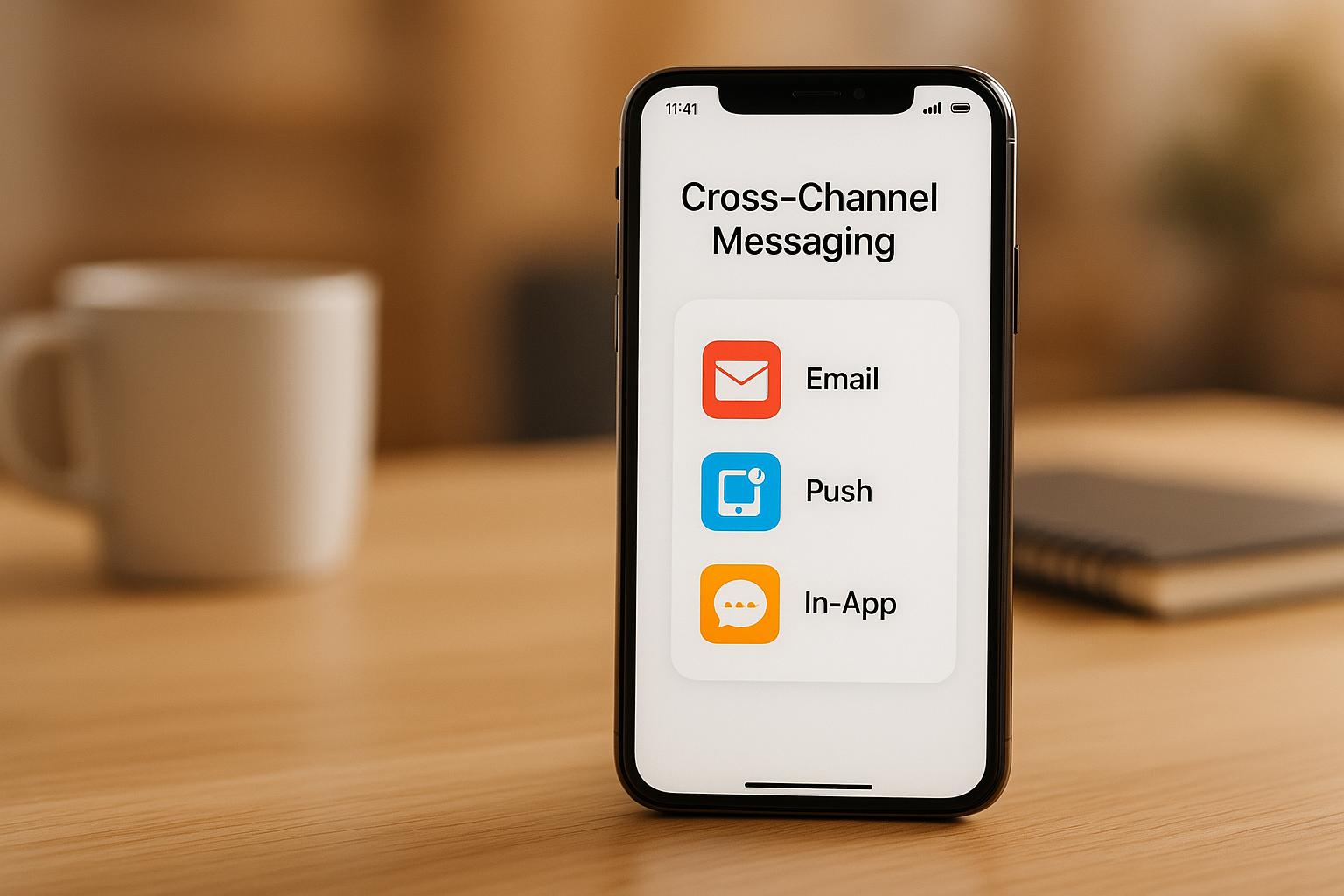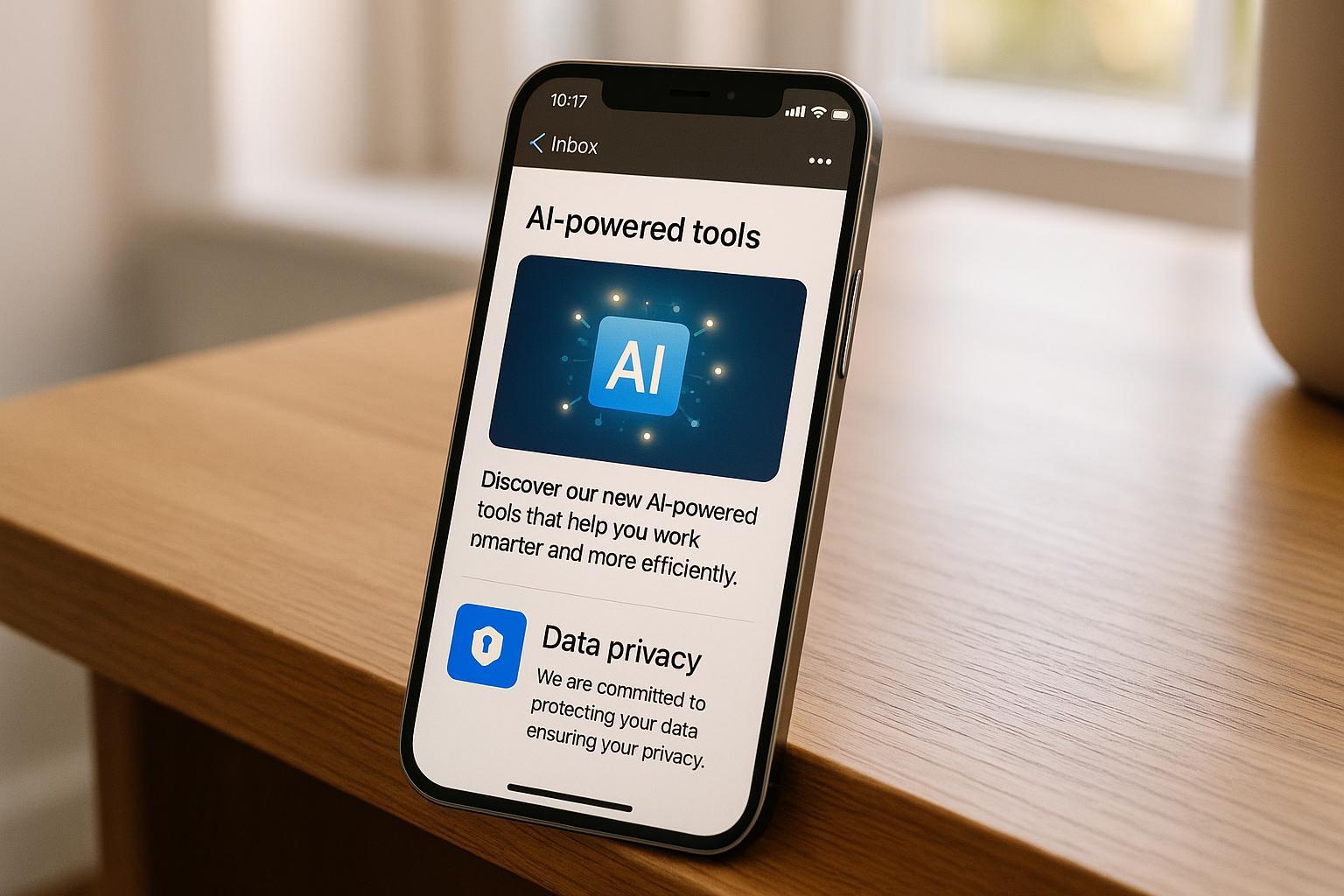Real-time targeting uses live user behavior and interactions to deliver personalized content instantly. This approach outperforms traditional methods by dynamically adjusting messaging based on real-time data, ensuring relevance across channels like email, mobile apps, social media, and in-store experiences. Key benefits include:
- Higher Engagement: Omnichannel strategies powered by real-time targeting can boost engagement rates by up to 250%.
- Unified Customer Profiles: Centralized platforms like CDPs consolidate data from all touchpoints for consistent personalization.
- AI and Automation: Predictive analytics and automation tools optimize campaigns, adjusting bids and content instantly based on user actions.
- Privacy Compliance: Tools like Consent Management Platforms and first-party data strategies ensure adherence to GDPR and CCPA regulations.
David Yurman's Omnichannel Marketing Strategy

Core Components of Real-Time Targeting Strategies
Real-time targeting in omnichannel marketing thrives on three interconnected elements. Together, they turn fragmented customer interactions into cohesive, personalized experiences that deliver measurable outcomes.
Unified Customer Profiles
At the heart of effective real-time targeting is the ability to consolidate data from every customer interaction into a single, detailed profile. Tools like CDPs or DMPs make this possible by pulling information from websites, mobile apps, emails, social media, in-store visits, and customer service channels. These profiles capture both quantitative metrics - like page views, time spent on site, downloads, form submissions, and cart actions - and qualitative insights from surveys. This unified approach ensures consistent identity resolution. Here's a compelling stat: businesses with strong omnichannel engagement retain 89% of their customers, compared to just 33% for those with weaker strategies.
To make this work seamlessly, you’ll need a solid technical setup. Low-latency pipelines, along with modern SDKs and APIs, are critical for capturing and processing data in real time. Once this foundation is in place, it paves the way for AI-driven predictive insights.
AI and Predictive Analytics
Artificial intelligence takes your historical and live data and turns it into actionable predictions about customer behavior. For example, AI can analyze live signals - like extended time spent reading product reviews, items added to a cart, or repeated visits to specific product categories - and calculate the likelihood of conversion. By acting on these insights, real-time personalization can boost conversion rates by up to 20%.
Predictive analytics also ensures businesses reach customers at the perfect moment, maximizing the chances of engagement. Modern PPC platforms, for instance, use these insights to automatically adjust bids and refine audience targeting in real time. As customer behaviors shift, these models adapt, keeping your targeting strategies relevant and effective.
Automation Tools for Real-Time Campaigns
Automation tools are the driving force that turns insights into immediate, multi-channel actions. These platforms enable businesses to launch campaigns triggered by real-time customer behaviors, ensuring timely and context-aware messaging. Key automation features include dynamic programmatic bidding, which adjusts based on user signals and performance metrics. This reduces delays and minimizes manual errors while optimizing ad spend.
Consider this: if a customer abandons their shopping cart, automation tools can instantly send a personalized email, display retargeting ads, or push notifications tailored to that customer’s preferences and behavior. Dashboards tracking metrics like impressions, click-through rates, cost per click, and conversions help monitor performance and fine-tune campaigns. This creates a coordinated ecosystem where messaging across channels feels seamless - not overwhelming.
Together, these components form a responsive system designed to engage customers in real time, across every touchpoint.
Key Channels for Omnichannel Real-Time Targeting
To make real-time targeting work effectively, it’s all about orchestrating different channels to work together as a unified system. Each channel has its own strengths, and when combined, they create seamless touchpoints that respond instantly to customer actions and preferences.
Email Marketing
Email is a powerhouse for delivering immediate, personalized messages that guide customers through their journey.
Behavior-based automation is changing how businesses engage via email. Think about abandoned cart reminders, follow-ups based on browsing activity, or product view triggers - these emails connect with customers at just the right moment. Platforms like Customer.io, Drip, Omnisend, and Klaviyo are leading the charge, especially for e-commerce and SaaS businesses, by enabling these micro-moment interactions.
AI-driven send time optimization takes personalization to another level. Tools like Seventh Sense and LTV.ai analyze individual behavior to predict the best time to send emails. This ensures your message lands when the recipient is most likely to open it, boosting engagement rates.
Modern email campaigns are also stepping up with dynamic and interactive content. Platforms like Zembula and Sendspark let you embed personalized videos, real-time product suggestions, and interactive elements directly into emails. These features make emails more engaging and encourage immediate actions.
But email is just one piece of the puzzle. Mobile channels are equally important for capturing those real-time moments.
Mobile Apps, SMS, and Push Notifications
Mobile channels thrive on immediacy, delivering notifications at the perfect time, based on customer behavior, location, or context.
Push notifications are ideal for time-sensitive updates, like special offers or location-based messages. For instance, a customer nearing a store might get a discount notification, or a cart reminder could nudge them to complete a purchase. The trick is to keep these notifications relevant - poorly timed or generic messages can easily backfire.
SMS marketing stands out with its high open rates. Platforms like Salesmsg allow businesses to send instant, behavior-triggered messages. For example, if a customer doesn’t open a key email within 24 hours, an SMS follow-up ensures they don’t miss out.
Mobile apps offer even more possibilities. They track in-app behavior to uncover customer preferences and use geofencing for location-based targeting. Apps also act as central hubs, linking and coordinating messages across other channels.
Web, Social Media, and In-Store Integration
To create a seamless journey, your online and offline touchpoints need to align perfectly, working together to deliver a unified experience.
Website personalization is the backbone of web-based real-time targeting. By using dynamic, behavior-based elements, websites deliver experiences tailored to each visitor. Features like real-time chat, personalized product recommendations, and pop-ups triggered by user behavior can significantly boost conversion rates.
Social media integration extends real-time targeting to platforms like Facebook and Instagram. By using custom audiences built from email lists or website data, businesses can deliver highly targeted ads. Social interactions can also trigger responses on other channels - for instance, someone engaging with a social post might receive a follow-up email or see related content on their next site visit.
In-store integration bridges the gap between digital and physical experiences. When customers visit a store, their digital profiles can guide in-person interactions. Sales associates equipped with information about a customer’s history, preferences, and recent online behavior can provide a more tailored shopping experience. Additionally, point-of-sale systems synced with digital profiles ensure that in-store purchases influence future online recommendations and communications.
To manage these complex integrations, tools like the Email Service Business Directory can help businesses find platforms with robust APIs, cross-channel automation, and features designed for true omnichannel coordination.
Imagine this: a customer abandons their cart, triggering an email. If they don’t act, they see a retargeting ad on social media. Still no response? An SMS or push notification follows. When done right, this multi-channel approach feels helpful, not overwhelming, and strengthens your omnichannel strategy to drive engagement and measurable results.
Best Practices for Real-Time Targeting Implementation
To make real-time targeting work effectively, you need three key elements: unified customer data, dynamic personalization, and strict adherence to privacy regulations.
Managing and Unifying Customer Data
At the heart of real-time targeting is the need for a complete and unified view of your customers. Fragmented data - scattered across tools like email platforms, social media, website analytics, and point-of-sale systems - creates a major roadblock to delivering the seamless experiences people now expect.
Enter Centralized Customer Data Platforms (CDPs). These platforms consolidate data from every touchpoint, ensuring consistent identity resolution across devices and creating detailed customer profiles. With a CDP in place, you can eliminate silos and establish a single source of truth.
Start by focusing on first-party data collection. Use registration forms, surveys, or incentivized lead generation to gather this data. Tools like SDKs, tags, and APIs can be integrated into your websites and apps to capture both quantitative behavior (like clicks and purchases) and qualitative insights (such as survey responses) in real time. For instance, Google Analytics 4 has become a go-to tool for tracking user interactions. When integrated with platforms like Google Ads, Meta Ads, and LinkedIn Ads, it ensures seamless data flow from collection to campaign execution.
Keeping your data pipelines low-latency is critical to maintaining real-time responsiveness.
Dynamic Personalization Across Channels
Once your data is unified, the next step is to use it to personalize content in real time. Real-time targeting shines when brands adapt their messaging instantly based on live customer behavior. Relying on static audience segments isn't enough anymore - these need to be updated automatically based on actions like cart abandonment or recent page visits.
Micro-segmentation can help refine your targeting. Group users based on live intent signals such as location, time of day, or even weather conditions. Combine this with demographic data, sentiment analysis, and survey results to build detailed profiles. This allows you to serve product recommendations based on browsing behavior, location-specific offers that match current conditions, or messaging that aligns with a user’s mood.
Predictive analytics takes this a step further. Machine learning models can analyze both live and historical data to forecast behaviors like purchase intent or churn risk. This enables smarter decisions about budget allocation and bid adjustments. AI-driven tools can help align your ad spend with high-intent actions, ensuring you get the most out of your campaigns.
Dynamic personalization, however, must always go hand-in-hand with strong compliance measures to ensure trustworthiness.
Compliance and Privacy Requirements
Personalization is powerful, but it must be balanced with robust privacy and compliance practices. Before launching any behavioral targeting campaigns, make sure your technical infrastructure is up to the task. Consent Management Platforms (CMPs) are a must - they help secure clear permissions from users while enabling tracking technologies where appropriate.
Real-time data in a CDP can also enhance compliance with regulations like GDPR and CCPA. As the industry moves toward a cookieless future, combining first-party data with privacy-friendly identifiers is essential. Google's Enhanced Conversions, for example, uses first-party data in a way that respects user privacy while maintaining targeting effectiveness.
Transparency is key. Be clear about what data you’re collecting, how it will be used, and provide straightforward opt-out options. Regularly review your privacy policies and ensure you’re obtaining explicit consent for data usage. Make it easy for customers to manage their preferences.
If you’re looking for email marketing platforms that prioritize privacy while supporting real-time targeting, the Email Service Business Directory is a helpful resource. Many platforms listed there offer built-in compliance tools and privacy-focused features, making it easier to meet regulatory requirements without compromising your campaigns.
Lastly, it’s worth noting that 86% of senior marketers agree that a cohesive omnichannel strategy is critical to the customer journey. This highlights the importance of integrating unified data, dynamic personalization, and privacy compliance into your strategy. Without these elements, even the most advanced targeting tools may fall short of delivering the seamless experiences today’s consumers expect.
sbb-itb-6e7333f
Common Challenges in Real-Time Omnichannel Targeting
Implementing real-time targeting across multiple channels can be a tough nut to crack. It’s a process that comes with its fair share of challenges, but understanding these hurdles and having strategies in place to tackle them can make all the difference. Below, we’ll dive into some of the key obstacles and practical ways to address them.
Data Fragmentation and Silos
One of the most common issues is fragmented customer data. When information about your customers is scattered across various platforms - like email systems, social media, analytics tools, CRM software, and point-of-sale systems - it’s nearly impossible to create a unified customer profile for real-time targeting. This lack of integration can lead to inconsistent identity resolution, making it harder to track customer behavior across channels. The result? You might end up spending money targeting the wrong audience instead of delivering personalized, timely ads.
The fix? Data consolidation. By bringing together data from all touchpoints into a centralized system, such as a Customer Data Platform (CDP) or Data Management Platform (DMP), you can achieve a unified view of your audience. Feeding real-time analytics into these platforms ensures updated segments and accurate personalization. To make this work, invest in robust, low-latency data pipelines - tools like Apache Kafka or AWS Kinesis are great for this - and prioritize effective data cleaning and enrichment. This approach ensures you’re working with accurate, actionable data.
But data isn’t the only challenge. Let’s talk about the complexities of integrating different technologies.
Technology Integration and Scalability
Getting various systems to talk to each other while maintaining the speed required for real-time operations is another big hurdle. Your analytics tools need to integrate seamlessly with advertising platforms like Google Ads, Meta Ads, and LinkedIn Ads to ensure smooth data flow from collection to campaign execution. Many of these platforms now use AI and machine learning to optimize campaigns, adjusting bids and refining audience targeting based on real-time behavior.
Scalability is the name of the game here. To handle growth, make sure your websites and apps are equipped with SDKs, tags, or APIs to capture both quantitative and qualitative data in real time. Using stream processing frameworks can help manage continuous data flows, while automation tools can reduce latency and minimize manual errors. For example, automated bidding strategies can take the guesswork out of campaign optimization, allowing you to maintain efficiency as you scale.
Of course, with all this data flowing around, privacy and security concerns can’t be ignored.
Privacy and Security Concerns
Handling large volumes of sensitive customer data in real time brings its own set of challenges, especially when it comes to privacy and security. Businesses must comply with strict data protection laws like GDPR and CCPA while maintaining customer trust. Collecting high-quality first-party data is a great starting point - not only is it more reliable, but it also helps you stay on the right side of regulations. Being transparent about data collection, such as through clear and easy-to-understand signup forms, can go a long way in building trust.
Privacy-focused tools like Google’s Enhanced Conversions and Google Analytics 4 can help you collect and use first-party data while staying compliant. Additionally, setting up secure, low-latency data pipelines with proper cleaning and normalization ensures that your data processes are both efficient and secure. By clearly communicating how customer data will be used and adopting privacy-conscious tools, you can strike the right balance between delivering personalized experiences and respecting user privacy.
Using the Email Service Business Directory
Choosing the right email marketing platform can be daunting, especially with challenges like fragmented data and strict privacy regulations. The Email Service Business Directory simplifies this process by gathering top email marketing platforms and service providers in one place. This makes it easier to compare options and find the right fit for your real-time campaign needs. By using this resource, you can align your platform choice with the strategic goals discussed earlier.
How the Directory Simplifies Platform Selection
The Directory streamlines the selection process by offering detailed comparisons, user reviews, and curated lists of top platforms. Instead of spending weeks researching vendors scattered across the web, you can quickly identify platforms with the features you need for real-time targeting. It highlights options for businesses of all sizes, from budget-friendly tools for small companies to enterprise-level systems. Key features emphasized include real-time analytics integration, low-latency APIs for instant data exchange, dynamic audience segmentation, and seamless compatibility with advertising systems like Google Ads, Meta Ads, and LinkedIn Ads . Additionally, user reviews and expert ratings provide clarity on how well these platforms deliver on their promises.
Features That Support Real-Time Targeting
The Directory focuses on platforms designed for real-time targeting, featuring tools with advanced automation, CRM integration, and omnichannel campaign management. Many of these platforms integrate with CDPs and support low-latency data pipelines to enable unified targeting across devices. They also offer real-time segment syncing, AI-powered automation, and stream processing for instant data cleaning and enrichment . Some platforms even include stream processing pipelines to capture and process user analytics in real time, handling data cleaning, enrichment, and normalization seamlessly. Privacy compliance is another priority, with platforms integrating Consent Management tools and features like Google’s Enhanced Conversions to ensure first-party data is used responsibly.
Maximizing ROI with the Right Email Service
Choosing the right platform through the Directory can significantly enhance your campaign ROI. Platforms with strong real-time features help eliminate wasted budget by targeting only the most relevant audiences. They enable highly personalized ads that reflect users' current behavior and preferences. These tools also optimize ad spend by dynamically adjusting bids based on live user signals and reallocating resources to the best-performing channels or creative assets. Many platforms support predictive analytics, feeding performance data back into your advertising system to prioritize high-value users. For U.S.-based businesses, the Directory is particularly useful as it highlights platforms that meet local standards, use USD currency formats, and integrate seamlessly with popular U.S.-based CRM and e-commerce tools.
Conclusion
Real-time targeting transforms omnichannel marketing into a dynamic, adaptable approach, boosting engagement rates by up to 250% compared to single-channel strategies. It also aligns with the 90% of customers who expect consistent brand interactions across channels. These benefits highlight several fundamental points.
Key Points Summary
Achieving success with real-time targeting relies on three core elements: unified customer data, intelligent automation, and cross-channel integration. By consolidating data from various touchpoints through Customer Data Platforms, businesses can create a single, reliable source of information. This not only enhances targeting precision across channels but also minimizes wasted spending on irrelevant audiences.
The technical foundation is just as crucial as the strategy itself. Low-latency data pipelines, stream processing systems, and integrations with major platforms like Google Ads, Meta Ads, and LinkedIn Ads form the backbone of real-time responsiveness. When paired with AI-driven predictive analytics, these tools enable businesses to anticipate customer needs and deliver tailored messages at exactly the right moment.
Equally important is privacy compliance. As the industry shifts toward a cookieless future, first-party data collection and privacy-focused targeting methods are becoming essential. Tools like Google’s Enhanced Conversions and Consent Management Platforms ensure businesses can maintain effective real-time targeting while adhering to regulations like GDPR and CCPA.
The payoff is undeniable. Real-time targeting facilitates quick A/B testing, dynamic budget adjustments, and continuous campaign optimization, turning marketing investments into a precise revenue generator. Companies can dynamically adjust bids based on user intent, reallocate budgets to high-performing segments in real time, and deliver personalized experiences that lead to higher conversion rates.
With these principles in mind, businesses can take actionable steps to implement real-time targeting.
Next Steps for Businesses
To get started, businesses should begin by mapping their customer journey. Identify the key moments where real-time personalization will have the greatest impact. Strengthen first-party data collection through methods like registration forms, surveys, and incentivized lead generation to gain deeper insights into customer preferences and behaviors.
Next, choose the right technology stack to support your strategy. Resources like the Email Service Business Directory can simplify the process of evaluating email marketing platforms and service providers. These tools are essential for implementing advanced automation, CRM integration, and managing omnichannel campaigns effectively.
Start small with pilot campaigns that use event tagging and dynamic segmentation. Leverage this data to create audience segments that update automatically based on real-time user actions. Then, personalize your content and messaging based on current browsing behavior and engagement patterns.
FAQs
How can businesses stay compliant with privacy regulations when using real-time targeting in omnichannel marketing?
When integrating real-time targeting into omnichannel marketing, protecting customer privacy should be a top priority. Start by being upfront with your audience - clearly explain how their data will be collected, stored, and used. If laws like GDPR or CCPA apply, make sure to secure explicit consent when necessary.
It’s equally important to put robust data security measures in place to protect customer information from breaches. Regularly reviewing your marketing practices will help ensure they stay in line with changing privacy regulations. Leveraging tools or platforms designed with privacy compliance in mind can make managing these responsibilities much easier.
What technologies do you need to implement real-time targeting in omnichannel marketing?
To make real-time targeting work effectively across various marketing channels, you’ll need the right mix of tools and technology. Here are the essentials:
- Customer Data Platforms (CDPs): These platforms gather and unify customer data from different sources, creating a complete profile for every user. Think of it as your central hub for understanding your audience.
- Artificial Intelligence (AI) and Machine Learning (ML): These tools dig into data to uncover patterns, provide personalized suggestions, and predict what your customers might do next - all in real time.
- Marketing Automation Tools: These handle the heavy lifting of running campaigns across email, social media, mobile, and more, ensuring your messages are consistent and sent at just the right moment.
When these technologies work together, they allow businesses to create tailored experiences that truly connect with customers, boosting engagement across all channels.
How do AI and predictive analytics improve real-time targeting to boost customer engagement?
AI and predictive analytics are transforming real-time targeting by sifting through enormous amounts of customer data to uncover patterns and predict future actions. This means businesses can send highly tailored messages and offers across various channels, ensuring the right audience gets the right content at just the right moment.
With these tools, brands can stay ahead by anticipating customer needs, fine-tuning timing, and creating seamless experiences that boost engagement. For instance, AI can customize email campaigns to match individual preferences, while predictive analytics can determine which promotions are likely to appeal to specific customer groups.


